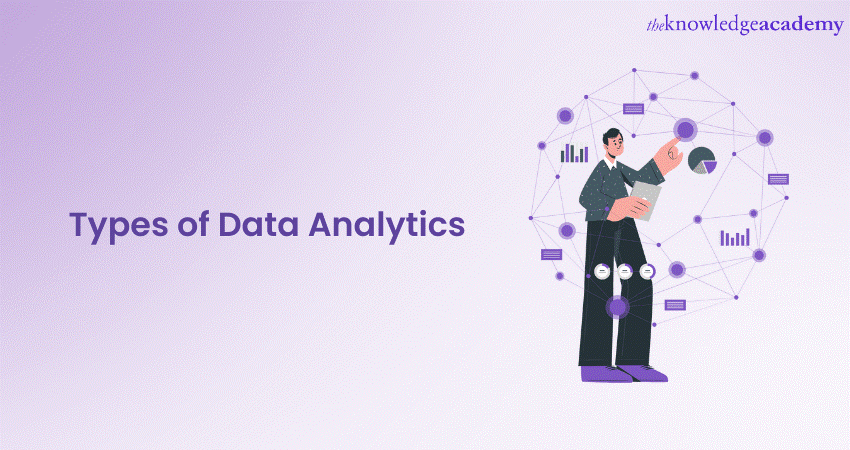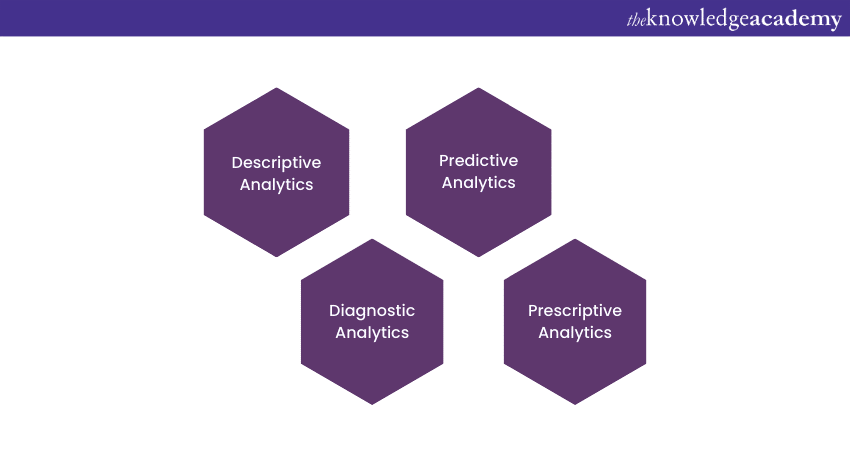We may not have the course you’re looking for. If you enquire or give us a call on 01344203999 and speak to our training experts, we may still be able to help with your training requirements.
Training Outcomes Within Your Budget!
We ensure quality, budget-alignment, and timely delivery by our expert instructors.

In the modern digital era, data is often considered to be our most important resource. Therefore, organisations often rely on Data Analytics to gain valuable insights and make informed decisions. Data Analytics refers to the process of examining large datasets to uncover patterns, trends, and correlations. However, it is only a broad term as there are different Types of Data Analytics.
According to Fortune Business Insights, the global Big Data Analytics market size was valued at £212.41billion in 2022 and is projected to grow from £240.29 billion in 2023 to £582.26billion by 2030. This statistic shows the exponential projected growth of the market, which in turn, prompts aspiring professionals to tap into Data Analytics and its different types. This blog explores the different Types of Data Analytics and their significance in various domains. Read more to find out!
Table of Contents
1) Understanding Data Analytics
2) What are the different Types of Data Analytics?
a) Descriptive analytics
b) Diagnostic analytics
c) Predictive analytics
d) Prescriptive analytics
3) Real-world Applications of Data Analytics
4) Challenges and Limitations of Data Analytics
5) Conclusion
Understanding Data Analytics
Before we examine the different Types of Data Analytics, we will first define What is Data Analytics. Data Analytics can be described as the process of examining vast sets of data to uncover valuable insights, patterns, and trends. It involves collecting, cleaning, transforming, and analysing data to extract meaningful information that can drive informed decision-making and strategic actions.
In the modern digital era, Data Analytics plays a crucial role in helping businesses, organisations, and individuals make sense of the massive amounts of data generated daily. Data Analytics relies on advanced technologies, such as machine learning, artificial intelligence, and data visualisation tools, to process and analyse large datasets efficiently. Skilled data professionals, including Data Scientists and Analysts, play a vital role in interpreting the data and translating it into actionable insights.
Unlock the power of data with our Advanced Data Analytics Certification Course. Sign up now!
What are the different Types of Data Analytics?
This section of the blog will examine the different Types of Data Analytics.

Descriptive analytics
Descriptive analytics is a category of data analytics that focuses on understanding and summarising historical data. It involves examining past events and trends within a dataset to gain insights and draw conclusions. Descriptive analytics provides a snapshot of what has happened, allowing businesses to gain a better understanding of their data and make informed decisions based on past patterns.
In descriptive analytics, various techniques are used to summarise and visualise data. These techniques include data aggregation, summary statistics, and data visualisation through charts, graphs, and dashboards. By employing these methods, businesses can identify key performance indicators (KPIs), trends, and patterns within their data.
For example, a retail company can use descriptive analytics to analyse sales data and gain insights into the best-selling products, peak sales periods, and customer buying patterns. By understanding these patterns, the company can optimise inventory management, plan marketing campaigns effectively, and make data-driven decisions to improve overall performance.
Diagnostic analytics
Diagnostic analytics is focused on understanding the causes and reasons behind specific events or outcomes. It involves analysing data to uncover the factors that contribute to a particular situation or trend. Diagnostic analytics goes beyond describing what happened and investigates why it happened, aiming to identify the root causes behind certain patterns or incidents.
Techniques used in diagnostic analytics include root cause analysis, comparative analysis, and cohort analysis. These techniques help businesses uncover relationships, correlations, and dependencies within their data to understand the underlying causes of specific outcomes.
For instance, a technology company may use diagnostic analytics to investigate why a software release experienced a high number of bugs. By analysing various factors such as coding practices, testing procedures, and software dependencies, the company can detect the root causes of the issues and take corrective measures to improve future software releases.
Predictive analytics
Predictive analytics involves using historical data to make predictions and forecasts about future events or outcomes. It leverages statistical modelling, machine learning algorithms, and data mining techniques to identify patterns and trends within the data that can be used to predict future behaviour.
The techniques used in predictive analytics include regression analysis, time series forecasting, and classification algorithms. These techniques enable businesses to anticipate customer behaviour, market trends, demand patterns, and other critical factors that influence business outcomes.
For example, an e-commerce platform can utilise predictive analytics to predict customer churn. By analysing past customer behaviour, purchase history, and other relevant data, the platform can identify customers who are likely to churn in the future. This allows the company to take proactive measures to retain those customers by offering targeted promotions, personalised recommendations, or improved customer experiences.
Prescriptive analytics
Prescriptive analytics goes beyond predicting future events and aims to provide recommendations for optimal decision-making. It utilises advanced algorithms, mathematical models, and optimisation techniques to suggest the best course of action based on multiple variables and constraints.
Prescriptive analytics takes into account various scenarios and potential outcomes to help businesses make data-driven decisions. It considers the possible consequences of different choices and provides insights on the actions that are most likely to lead to desired outcomes.
Techniques used in prescriptive analytics include optimisation models, simulation techniques, and decision trees. These techniques enable businesses to evaluate different options, simulate the impact of their decisions, and make informed choices based on the desired goals.
For instance, a transportation company can use prescriptive analytics to identify the most efficient routes for delivery trucks. By considering factors such as traffic conditions, fuel costs, delivery time windows, and vehicle capacity, the company can optimise its delivery operations, reduce costs, and improve customer satisfaction.
Embark on a data-driven career journey with our Data Science Analytics Course. Join now!
Real-world applications of Data Analytics
Data analytics finds applications across various industries and domains. Here are some examples:
Business and marketing industry
In the business and marketing industry, Data Analytics is used for customer segmentation and targeting, market trend analysis, pricing optimisation, sales forecasting and social media analytics.
Healthcare industry
In the healthcare industry, Data Analytics is used for patient risk assessment, disease outbreak prediction, clinical decision support systems, drug effectiveness analysis and healthcare resource allocation.
Finance industry
In the finance industry, Data Analytics is used for fraud detection and prevention, risk modelling and management, investment portfolio optimisation, credit scoring and financial market analysis.
Challenges and limitations of Data Analytics
While Data Analytics offers numerous benefits, it also comes with challenges and limitations. Some common challenges include:
a) Data quality and accuracy
b) Privacy and ethical considerations
c) Data governance and security
d) Lack of skilled data professionals
e) Interpreting complex analytics outputs

Conclusion
All in all, Data Analytics plays a vital role in helping organisations unlock the potential of their data. By understanding the different Types of Data Analytics and their applications, businesses can gain valuable insights, optimise their operations, and make informed decisions. Embracing data-driven strategies is crucial for staying competitive in today's data-centric world.
Want to take your data skills to the next level? Explore our Big Data and Analytics Training Course today!
Frequently Asked Questions
Upcoming Data, Analytics & AI Resources Batches & Dates
Date
 Hadoop Big Data Certification
Hadoop Big Data Certification
Thu 12th Sep 2024
Thu 12th Dec 2024







 Top Rated Course
Top Rated Course


 If you wish to make any changes to your course, please
If you wish to make any changes to your course, please


